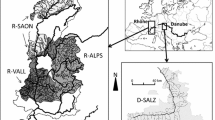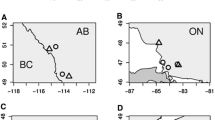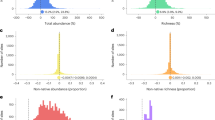Abstract
Fish assemblage structures show non-random patterns along the longitudinal gradient of rivers. We analysed the impact of climate change on riverine fish assemblages using the Fish Zone Index—a structural index reflecting these conditions. The dataset contained 92 fish species at 559 sampling sites spread over 14 European countries. We regressed the Fish Zone Index in a hierarchical modelling framework with independent variables describing river characteristics and climate conditions. Future changes were predicted according to three future emission scenarios (A1b, A2, and B1) and two time periods (2050s, and 2080s). The final model contained seven independent variables (river slope, size of upstream catchment, wetted width, elevation, maximum temperature of warmest month, mean temperature of warmest quarter of the year in the upstream catchment, and temperature range) and showed highly satisfactory performance (adjR2 > 0.6). The mean increase of the Fish Zone Index was between 0.25 and 0.36 for the 2050s and between 0.36 and 0.41 in the 2080s. Maximum values reached levels of 0.92 and 1.18, respectively, for the two time periods. Major changes of fish assemblages were found in mediterranean as well as in small rivers highlighting the need of timely conservation management.







Similar content being viewed by others
References
Aarts, B. G. W. & P. H. Nienhuis, 2003. Fish zonations and guilds as the basis for assessment of ecological integrity of large rivers. Hydrobiologia 500: 157–178.
Almodóvar, A., G. G. Nicola, D. Ayllón & E. Benigni, 2012. Global warming threatens the persistence of Mediterranean brown trout. Global Change Biology 18: 1549–1560.
Belliard, J., P. Boet & E. Tales, 1997. Regional and longitudinal patterns of fish community structure in the Seine River basin, France. Environmental Biology of Fishes 50: 133–147.
Beyer, H. L., 2012. Geospatial Modelling Environment. Spatial Ecology, http://www.spatialecology.com/gme.
Bosshard, T., M. Carambia, K. Goergen, S. Kotlarski, P. Krahe, M. Zappa & C. Schär, 2013. Quantifying uncertainty sources in an ensemble of hydrological climate-impact projections. Water Resources Research 49: 1523–1536.
Brosse, S., 2001. Utilisation of non-supervised neural networks and principal component analysis to study fish assemblages. Ecological Modelling 146: 159–166.
Buisson, L. & G. Grenouillet, 2009. Contrasted impacts of climate change on stream fish assemblages along an environmental gradient. Diversity and Distributions 15: 613–626.
Buisson, L., L. Blanc & G. Grenouillet, 2008a. Modelling stream fish species distribution in a river network: the relative effects of temperature versus physical factors. Ecology of Freshwater Fish 17: 244–257.
Buisson, L., W. Thuiller, S. Lek, P. Lim & G. Grenouillet, 2008b. Climate change hastens the turnover of stream fish assemblages. Global Change Biology 14: 2232–2248.
Buisson, L., G. Grenouillet, S. Villéger, J. Canal & P. Laffaille, 2013. Toward a loss of functional diversity in stream fish assemblages under climate change. Global Change Biology 19: 387–400.
Busby, J. R., 1991. BIOCLIM—a bioclimate analysis and predictionsystem. Plant Protection Quarterly 6: 8–9.
Caissie, D., 2006. The thermal regime of rivers: a review. Freshwater Biology 51: 1389–1406.
Chambers, J. M. & T. Hastie, 1992. Statistical Models. S. Wadsworth & Brooks/Cole, Pacific Grove: 608.
Cohen, J., P. Cohen, S. West & L. S. Aiken, 2003. Applied Multiple Regression/Correlation Analysis for the Behavioral Sciences. Applied Multiple Regression Correlation Analysis for the Behavioral Sciences. Lawrence Erlbaum, Mahwah: 703.
Comte, L., & G. Grenouillet, 2013. Do stream fish track climate change? Assessing distribution shifts in recent decades. Ecography, http://doi.wiley.com/10.1111/j.1600-0587.2013.00282.x.
Comte, L., L. Buisson, M. Daufresne & G. Grenouillet, 2012. Climate-induced changes in the distribution of freshwater fish: observed and predicted trends. Freshwater Biology 58: 625–639.
Dudgeon, D., A. H. Arthington, M. O. Gessner, Z.-I. Kawabata, D. J. Knowler, C. Lévêque, R. J. Naiman, A.-H. Prieur-Richard, D. Soto, M. L. J. Stiassny & C. A. Sullivan, 2006. Freshwater biodiversity: importance, threats, status and conservation challenges. Biological Reviews of the Cambridge Philosophical Society 81: 163–182.
Dussling, U., R. Berg, H. Klinger & C. Wolter, 2004. Assessing the ecological status of river systems using fish assemblages. In Steinberg, C., W. Calmano, H. Klapper & R.-D. Wilken (eds), Handbuch Angewandte Limnologie. Ecomed Verlagsgruppe, Lech.
Eaton, J. G. & R. M. Scheller, 1996. Effects of climate warming on fish thermal habitat in streams of the United States. Limnology and Oceanography American Society of Limnology and Oceanography 41: 1109–1115.
Elliott, J. M., 2000. Pools as refugia for brown trout during two summer droughts: trout responses to thermal and oxygen stress. Journal of Fish Biology 56: 938–948.
ESRI. 2011. Environmental Systems Research Institute, ArcGIS Desktop, Version 10.0, ArcInfo license. Redlands, California.
Esselman, P. C. & J. D. Allan, 2010. Relative influences of catchment- and reach-scale abiotic factors on freshwater fish communities in rivers of northeastern Mesoamerica. Ecology of Freshwater Fish 19: 439–454.
Filipe, A. F., J. E. Lawrence & N. Bonada, 2012. Vulnerability of stream biota to climate change in mediterranean climate regions: a synthesis of ecological responses and conservation challenges. Hydrobiologia. doi:10.1007/s10750-012-1244-4.
Filipe, A. F., D. Markovic, F. Pletterbauer, C. Tisseuil, A. De Wever, S. Schmutz, N. Bonada & J. Freyhof, 2013. Forecasting fish distribution along stream networks: brown trout (Salmo trutta) in Europe. Diversity and Distributions 19: 1059–1071.
Fox, J. & G. Monette, 1992. Generalized collinearity diagnostics. Journal of the American Statistical Association 87: 178–183.
Frissell, C. A., W. J. Liss, C. E. Warren & M. D. Hurley, 1986. A hierarchical framework for stream habitat classification: viewing streams in a watershed context. Environmental Management 10: 199–214.
Fritsch, A., 1872. Die Wirbeltiere Böhmens. Ein Verzeichnis aller bisher in Böhmen beobachteten Säugetiere, Vögel, Amphibien und Fische. Development. Archiv für die Landesdurchforschung von Böhmen: 152 pp.
Gasith, A. & V. H. Resh, 1999. Streams in Mediterranean climate regions: abiotic influences and biotic responses to predictable seasonal events. Annual Review of Ecology and Systematics 30: 51–81.
Giorgi, F. & P. Lionello, 2008. Climate change projections for the Mediterranean region. Global and Planetary Change 63: 90–104.
Grenouillet, G., L. Buisson, N. Casajus & S. Lek, 2010. Ensemble modelling of species distribution: the effects of geographical and environmental ranges. Ecography 34: 9–17.
Hansen, M. M., D. E. Ruzzante, E. E. Nielsen, D. Bekkevold & K.-L. D. Mensberg, 2002. Long-term effective population sizes, temporal stability of genetic composition and potential for local adaptation in anadromous brown trout (Salmo trutta) populations. Molecular Ecology 11: 2523–2535.
Hari, R. E., D. M. Livingstone, R. Siber, P. Burkhardt-Holm & H. Guttinger, 2006. Consequences of climatic change for water temperature and brown trout populations in Alpine rivers and streams. Global Change Biology 12: 10–26.
Haunschmid, R., G., Wolfram, T., Spindler, W., Honsig-Erlenburg, R., Wimmer, A., Jagsch, E., Kainz,.K., Hehenwarter, B., Wagner, R., Konecny, R., Riedmüller, G., Ibel, B., Sasano, & N. Schotzko, 2006. Erstellung einer fischbaiserten Typologie österreichischer Fließgewässer sowie einer Bewertungsmethode des fischökologischen Zustandes gemäß EU-Wasserrahmenrichtlinie, Schriftenreihe des BAW, Band 23, Wien: 105 pp.
Hein, C. L., G. Öhlund & G. Englund, 2011. Dispersal through stream networks: modelling climate-driven range expansions of fishes. Diversity and Distributions 17: 641–651.
Heino, J., 2008. Regional gradient analysis of freshwater biota: do similar biogeographic patterns exist among multiple taxonomic groups? Journal of Biogeography 28: 69–76.
Heino, J., 2011. A macroecological perspective of diversity patterns in the freshwater realm. Freshwater Biology 56: 1703–1722.
Heino, J., R. Virkkala & H. Toivonen, 2009. Climate change and freshwater biodiversity: detected patterns, future trends and adaptations in northern regions. Biological Reviews of the Cambridge Philosophical Society 84: 39–54.
Hijmans, R. J., S. E. Cameron, J. L. Parra, P. G. Jones & A. Jarvis, 2005. Very high resolution interpolated climate surfaces for global land areas. International Journal of Climatology 25: 1965–1978.
Horwitz, R. J., 1978. Temporal variability patterns and the distributional patterns of stream fishes. Ecological Monographs Ecological Monographs 48: 307–321.
Huet, M., 1959. Profiles and biology of western European streams as related to fish management. Transactions of the American Fisheries Society 88: 155–163.
Hulme, P. E., 2005. Adapting to climate change: is there scope for ecological management in the face of a global threat? Journal of Applied Ecology 42: 784–794.
Ibarra, A. A., Y.-S. Park, S. Brosse, Y. Reyjol, P. Lim & S. Lek, 2005. Nested patterns of spatial diversity revealed for fish assemblages in a west European river. Ecology of Freshwater Fish 14: 233–242.
Illies, J., 1961. Versuch einer allgemeinen biozönotischen Gliederung der Fließgewässer. Internationale Revue der gesamten Hydrobiologie 46: 205–213.
IPCC, 2007. Climate change 2007: synthesis report contribution of working groups I, II and III to the fourth assessment report of the intergovernmental panel on climate change. In Pachauri, R. K. & A. Reisinger (eds), Core Wrting Team. IPCC, Geneva.
Isaak, D. J., S. Wollrab, D. Horan & G. Chandler, 2012. Climate change effects on stream and river temperatures across the northwest U.S. from 1980 to 2009 and implications for salmonid fishes. Climatic Change 113: 499–524.
Jackson, D. A., P. R. Peres-Neto & J. D. Olden, 2001. What controls who is where in freshwater fish communities—the roles of biotic, abiotic, and spatial factors. Canadian Journal of Fisheries and Aquatic Sciences 58: 157–170.
Jacquez, J. A. & F. J. Mather, 1968. Linear regression with non-constant, unknown error variances: sampling experiments with least squares, weighted least squares and maximum likelihood estimators. Biometrics 24: 607–626.
Jungwirth, M., Haidvogl, G., Moog, O., Muhar, S. & S. Schmutz, 2003. Angewandte Fischökologie an Fließgewässern, Facultas, Wien: 552 pp, ISBN 3-8252-2113-X.
Lamouroux, N., J.-M. Olivier, H. Persat, M. C. Pouilly, Y. S. Souchon & B. Statzner, 1999. Predicting community characteristics from habitat conditions: fluvial fish and hydraulics. Freshwater Biology 42: 275–299.
Lasne, E., B. Bergerot, S. Lek & P. Laffaille, 2007. Fish zonation and indicator species for the evaluation of the ecological status of rivers: example of the Loire basin (France). River Research and Applications 23: 877–890.
Legendre, P. & L. Legendre, 2012. Numerical Ecology, 3rd ed. Elsevier, New York: 1006.
Lehner, B., P. Döll, J. Alcamo, T. Henrichs & F. Kaspar, 2006. Estimating the impact of global change on flood and drought risks in Europe: a continental, integrated analysis. Climatic Change 75: 273–299.
Logez, M., & D. Pont, 2012. Global warming and potential shift in reference conditions: the case of functional fish-based metrics. Hydrobiologia, 10.1007/s10750-012-1250-6.
Logez, M., P. Bady & D. Pont, 2012. Modelling the habitat requirement of riverine fish species at the European scale: sensitivity to temperature and precipitation and associated uncertainty. Ecology of Freshwater Fish 21: 266–282.
Luterbacher, J., D. Dietrich, E. Xoplaki, M. Grosjean & H. Wanner, 2004. European seasonal and annual temperature variability, trends, and extremes since 1500. Science 303: 1499–1503.
Lyons, J., 1989. Correspondence between the distribution of fish assemblages in Wisconsin streams and Omernik’s ecoregions. American Midland Naturalist 122: 163–182.
Mallows, C. L., 1973. Some comments on C p. Technometrics 15: 661–675.
Matulla, C., S. Schmutz, A. Melcher, T. Gerersdorfer & P. Haas, 2007. Assessing the impact of a downscaled climate change simulation on the fish fauna in an Inner-Alpine River. International Journal of Biometeorology 52: 127–137.
Miller, A., 2002. Subset Selection in Regression. Technometrics. Chapman and Hall, London: 256.
Miranda, L. E. & S. W. Raborn, 2000. From zonation to connectivity: fluvial ecology paradigms of the 20th century. Polskie Archivum Hydrobiologii 47: 5–19.
Nakicenovic, N. & R. Swart, 2000. IPCC Special Report on Emissions Scenarios (SRES). Cambridge University Press, Working Group III of the Intergovernmental Panel on Climate Change IPCC: 570 pp.
Nix, H. A., 1986. A biogeographic analysis of Australian elapid snakes. In Longmore, R. (ed.), Atlas of Elapid Snakes of Australia. Australian Government Publishing Service, Canberra: 4–15.
O’Brien, R. M., 2007. A caution regarding rules of thumb for variance inflation factors. Quality & Quantity 41: 673–690.
O’Donnell, M. S. & D. A. Ignizio, 2012. Bioclimatic predictors for supporting ecological applications in the conterminous United States. U.S. Geological Survey Data Series 691: 10.
Piñeiro, G., S. Perelman, J. P. Guerschman & J. M. Paruelo, 2008. How to evaluate models: observed vs. predicted or predicted vs. observed? Ecological Modelling 216: 316–322.
Poff, N. L., 1997. Landscape filters and species traits: towards mechanistic understanding and prediction in stream ecology. Journal of the North American Benthological Society 16: 391–409.
Poff, N. L. & J. K. H. Zimmerman, 2010. Ecological responses to altered flow regimes: a literature review to inform the science and management of environmental flows. Freshwater Biology 55: 194–205.
Pont, D., B. Hugueny, U. Beier, D. Goffaux, A. Melcher, R. Noble, C. Rogers, N. Roset & S. Schmutz, 2006. Assessing river biotic condition at a continental scale: a European approach using functional metrics and fish assemblages. Journal of Applied Ecology 43: 70–80.
Pont, D., B. Hugueny & T. Oberdorff, 2005. Modelling habitat requirement of European fishes: do species have similar responses to local and regional environmental constraints? Canadian Journal of Fisheries and Aquatic Sciences 62: 163–173.
R Development Core Team, 2011. R: a language and environment for statistical computing. R Foundation for Statistical Computing, Vienna. http://www.r-project.org.
Radinger, J., J. Kail, & C. Wolter, 2013. FIDIMO—a free and open source GIS based dispersal model for riverine fish. Ecological Informatics, http://linkinghub.elsevier.com/retrieve/pii/S1574954113000563.
Rahel, F. J. & W. A. Hubert, 1991. Fish assemblages and habitat gradients in a rocky mountain-great plains stream: biotic zonation and additive patterns of community change. Transactions of the American Fisheries Society 120: 319–332.
Reyjol, Y., A. Compin, A. A. Ibarra & P. Lim, 2003. Longitudinal diversity patterns in streams: comparing invertebrates and fish communities. Archiv für Hydrobiologie 157: 525–533.
Reyjol, Y., B. Hugueny, D. Pont, P. G. Bianco, U. Beier, N. Caiola, F. Casals, I. G. Cowx, A. Economou, M. T. Ferreira, G. Haidvogl, R. Noble, A. de Sostoa, T. Vigneron & T. Virbickas, 2007. Patterns in species richness and endemism of European freshwater fish. Global Ecology and Biogeography 16: 65–75.
Roberts, J. H. & N. P. Hitt, 2010. Longitudinal structure in temperate stream fish communities: evaluating conceptual models with temporal data. American Fisheries Society Symposium 73: 281–289.
Rodriguez, M. A. & P. Magnan, 1995. Application of multivariate analyses in studies of the organization and structure of fish and invertebrate communities. Aquatic Sciences-Research Across Boundaries 57: 199–216.
Roeckner, E., G. Bäuml, L. Bonaventura, R. Brokopf, M. Esch, M. Giorgetta, S. Hagemann, I. Kirchner, L. Kornblueh, E. Manzini, A. Rhodin, U. Schlese, U. Schulzweida & A. Tompkins, 2003. The atmospheric general circulation model ECHAM5. Max Planck Institute for Meteorology. Deutsches Klimarechenzentrum, Modellbetreuungsgruppe, Hamburg: 140.
Schager, E., & A. Peter, 2004. Methoden zur Untersuchung und Beurteilung der Fliessgewässer. Fische Stufe F. BUWAL. Mitteilungen zum Gewässerschutz Nr. 44: 62 pp.
Schinegger, R., C. Trautwein, A. Melcher & S. Schmutz, 2012. Multiple human pressures and their spatial patterns in European running waters. Water and Environment Journal 26: 261–273.
Schmutz, S., M. Kaufmann, B. Vogel, & M. Jungwirth, 2000a. Methodische Grundlagen und Beispiele zur Bewertung der fischökologischen Funktionsfähigkeit Österreichischer Fließgewässer. Vienna: 241 pp.
Schmutz, S., M. Kaufmann, B. Vogel, M. Jungwirth & S. Muhar, 2000b. A multi-level concept for fish-based, river-type-specific assessment of ecological integrity. Hydrobiologia 422–423: 279–289.
Schmutz, S., I. G. Cowx, G. Haidvogl & D. Pont, 2007. Fish-based methods for assessing European running waters: a synthesis. Fisheries Management and Ecology 14: 369–380.
Schwarz, G., 1978. Estimating dimension of a model. Annals of Statistics 6: 461–464.
Spearman, C., 1904. The proof and measurement of association between two things. The American Journal of Psychology 15: 72–101.
Steel, R. G. D. & J. H. Torrie, 1960. Principles and Procedures of Statistics. Principles and Procedures of Statistics. McGraw-Hill, New York: 287.
Thienemann, A., 1925. Die Binnengewässer Mitteleuropas. Schweizerbart, Stuttgart: 255.
Thorp, J. H., M. C. Thoms & M. D. Delong, 2006. The riverine ecosystem synthesis: biocomplexity in river networks across space and time. River Research and Applications 22: 123–147.
Vannote, R. L., G. W. Minshall, J. R. Sedell & C. E. Cushing, 1980. The river continuum concept. Canadian Journal of Fisheries and Aquatic Sciences 37: 130–137.
Vogt, J., P. Soille, R. Colombo & M. L. Paracchini, 2007. Development of a pan-European river and catchment database. Data Processing 270: 121–144.
Ward Jr, J. H., 1963. Hierarchical grouping to optimize an objective function. Journal of the American statistical association 58: 236–244.
Webb, B. W., D. M. Hannah, R. D. Moore, L. E. Brown & F. Nobilis, 2008. Recent advances in stream and river temperature research. Hydrological Processes 22: 902–918.
Wehrly, K. E., M. J. Wiley & P. W. Seelbach, 2003. Classifying regional variation in thermal regime based on stream fish community patterns. Transactions of the American Fisheries Society 132: 18–38.
Wold, S., 1976. Pattern recognition by means of disjoint principal components models. Pattern Recognition 8: 127–139.
Acknowledgements
The authors specially thank A. Schmidt-Kloiber, D. Markovic, C. Mielach, R. Schinegger and C. Trautwein for their valuable inputs to the manuscript as well as T. Cassidy and D. Thornbrugh for language corrections. The study was funded by the EU-project BioFresh–Biodiversity of Freshwater Ecosystems: Status, Trends, Pressures, and Conservation Priorities (Contract 226874, 7th Framework Programme). Parts of this research were supported by the EU-project EFI+ (Contract 044096, 6th Framework Programme). Special thanks are due to all project partners and institutions that provided data for the EFI+ project, especially: G. Haidvogl, T. Vehanen, T. Sutela, D. Pont, P.Bady, M. Logez, J. Belliard, C. Wolter, T. Klefoth, B. Halasi-Kovacs, P. Gabor, G. Maio, E. Marconato, T. Virbickas, T. Buijse, M. Beers, P. Debowski, P. Prus, W. Wisniewolski, J. S. Santos, P. Segurado, K. Battes, K. Battes, D. Garcia de Jalon, J. Gortazar, J. Solana, P. Bohman, U. Beier, B. Seers, J. Pettersson, A. Peter, E. Schager, I. Cowx and R. Noble. Finally, we thank two anonymous reviewers for valuable suggestions to improve the manuscript.
Author information
Authors and Affiliations
Corresponding author
Additional information
Handling editor: Odd Terje Sandlund
Rights and permissions
About this article
Cite this article
Pletterbauer, F., Melcher, A.H., Ferreira, T. et al. Impact of climate change on the structure of fish assemblages in European rivers. Hydrobiologia 744, 235–254 (2015). https://doi.org/10.1007/s10750-014-2079-y
Received:
Revised:
Accepted:
Published:
Issue Date:
DOI: https://doi.org/10.1007/s10750-014-2079-y




